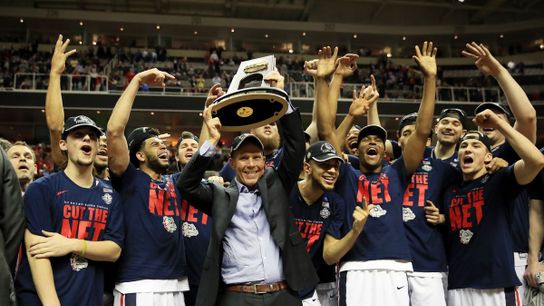Earlier this week we had a story on the tangible and intangible benefits a successful football program provides for its university. You should read it if you haven't already. That story was full of anecdotal evidence -- testimony from experts -- to support the point. Now we have something else to drive that point home: cold, hard data. While it does draw that data from a different sport, it still paints a picture of the real, live benefits a university can enjoy when it's winning in sports.
Gonzaga was the Cinderella of the 1999 NCAA Tournament. A tiny private school from the forgotten basketball outpost of Spokane, Wash., the Bulldogs entered that year's tournament with just one March Madness appearance in its entire history prior to that spring. But those 10th-seeded Bulldogs upset Minnesota in the first round, then did the same to No. 2 seed Stanford in the second round. They then went to Phoenix and beat Florida in the Sweet 16 before falling to eventual national champion Connecticut by five points in the Elite Eight. Head coach Dan Monson parlayed that success into the Minnesota job, but Gonzaga promoted assistant coach Mark Few to the big chair and the program never looked back.
The Bulldogs haven't missed the tournament since that 1999 run, winning 15 West Coast Conference tournaments in this 19-year streak with seven Sweet 16 trips, reaching a total of three Elite Eights and, tomorrow, the program's rise culminates with its first Final Four appearance. (Fittingly, this year's Final Four is also in Phoenix.)
Gonzaga is the basketball version of TCU, busting through the gate of national respect behind a battering ram of winning, winning, and winning some more. (The Gonzaga-TCU comparison even goes one level deeper in that Dennis Franchione got the TCU football program up and running before leaving for Alabama while the program reached even greater, sustained heights after promoting an assistant wise enough to stick around in Gary Patterson.) This is a Cinderella that morphed into Godzilla.
So now's as good a time as any to stop and take stock of how much the Bulldogs' rise has benefitted Gonzaga.
According to data released by the university's public relations office, Gonzaga has seen the following jumps from 1999 to 2017:
- Enrollment has grown from 4,061 to 7,572 (86.4 percent growth)
- Undergraduate applications have quadrupled from 1,841 to 7,342
- Freshman enrollment has spiked from 569 to 1,280 (124.9 percent)
- The faculty roster has grown from 279 to 434 (55.5 percent)
- The overall university budget has nearly quadrupled from $72.7 million to $283 million
As for the area a certain segment of society cares the most about: money.
- The endowment has bubbled from $67 million to $212.9 million (217.8 percent)
- Annual fundraising has grown from $13.4 million to $31.1 million (127.7 percent)
- Total donors have grown from 7,006 to 13,261 (a modest 89.3 percent growth)
To be fair, each of these numbers would have likely grown on their own regardless of Gonzaga's hardwood fortunes -- but it's hard to imagine they would have grown this much. For instance, according to the National Center for Education Statistics, national undergraduate enrollment increased 31 percent from 2000 to 2014. Gonzaga is roughly 50 percent ahead of those numbers.
And, as we outlined Wednesday, those increases will continue to benefit Gonzaga for generations to come in ways that will never show up on the athletics department's balance sheet. Nearly three thousand of those 3,500 extra students the school has recruited, accepted and enrolled between 1999 and 2017 will graduate within six years according to the school's published graduation rates. Many of those 3,000 students will stick around in Spokane and Washington state to benefit the local economy (as will many of those who don't graduate). Many more will migrate across the country, becoming trained and licensed brand ambassadors in communities the school's advertising budget could never reach on its own. They'll spread the Gonzaga gospel through the decals they stick to their cars and the t-shirts they wear to the grocery store. Most will send money back to the university, through donations, to visits back to basketball games, or both. Some will even send their children to Gonzaga someday.
It's impossible to precisely quantify how much exactly Gonzaga's success today will benefit the university in 2037. But it's impossible to deny that Gonzaga University is a different school today than it was in 1999, thanks in large part to its basketball program.
